Greetings from Palmia Observatory
Well here we are trying to summarize the other half of a week's worth of online conferences that occurred at the very same time. Last time we did the LISA XIII Symposium and this time we report on the online Humans To Mars Summit, August 31 - September 3, 2020. It is easy thinking about living on Mars, especially right now because of fires in nearby mountains the sunlight coming through the clouds takes on a definite reddish tint.
This four day virtual conference reviewed the status of technological development necessary to make the journey to Mars and how to survive and possibly thrive there on Mars. The summit was sponsored by ExoMars.org, which is a non-profit corporation which includes a wide range of experts and advocates of preparing the way to Mars in the 2030's.
 |
Humans To Mars Summit (Source: ExploreMars.org)
|
In order to get to Mars in the 2030's we need to review the journey into space so far and look into all of the new technologies and development needed to get there safely and return. This slide shows some of the federal investment form 1959-2015.
 |
U.S. Spending on human spaceflight (Source: 2020 Humans to Mars Summit)
|
Most human flights into space have been short term visits. Humans living on the ISS are usually there for not more than a 100 days or so. To make the visit to Mars requires duration in space of more than a 1000 days. We need to continue learning about how the astronauts will be affected and what new techniques are needed in order to work and thrive in that type of environment.
 |
Mars Endurance Requirements and previous history (Source: 2020 Humans to Mars Summit)
|
|
It is not just how will humans endure this long space voyage, but what is required to keep all of the life maintaining machinery working and repaired during this voyage. Many panelists talked about all of the lessons learned during early space flights about the reliability of CO2 scrubbers and water recycling systems and the number of spare parts necessary in order to ensure safe operation. Much more development and testing is planned for activities now on the ISS and later on at the lunar outposts in order to ensure that life systems can be maintained all the way to Mars and back.
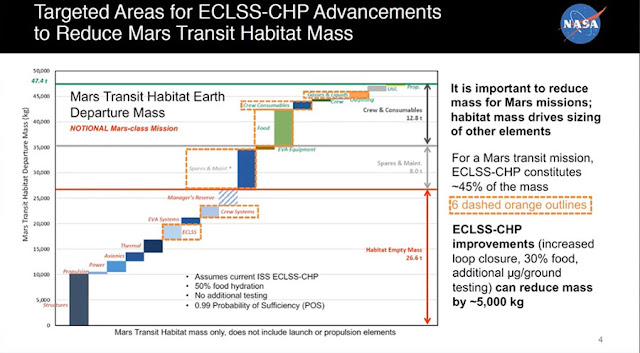 |
Going to Mars requires reducing mass in every system (Source: 2020 Humans to Mars Summit)
|
The mass in the Environmental Control and Life Support System (ECLSS) and its spare parts requirements is a key research activity. Here are some of the ECLSS systems previously relied on and tested in earlier space programs.
 |
| Going to Mars requires reducing mass in every system (Source: 2020 Humans to Mars Summit) |
Many panel discussions centered on how landing humans on Mars, with the greater mass required for food and water and air and protection from radiation, results in the requirement to be able to land much heavier vehicles on Mars than the earlier and much lighter rovers. The use of retrorocket propulsive slowing for the entire landing is very difficult because of the high mass of required fuel. Luckily, for landings on Mars, there are various ways of using the thin Martian atmosphere to slow the spacecraft and dissipate the kinetic energy. In this next slide we see an example where something like 99% of the spacecraft kinetic energy is dissipated high in the Martian atmosphere, then the landing sequence switches to parachutes to dissipate again about 99% of the remaining kinetic energy at mid altitudes, and finally retrorocket landing brings the remaining kinetic energy to zero at the Martian surface.
 |
Landing humans on Mars is much more difficult (Source: 2020 Humans to Mars Summit)
|
Getting rid of the kinetic energy at high altitudes relies on larger surfaces to slow the spacecraft. For heavy human based spacecraft the required heat shield surface area is larger than can fit in the largest launching rocket shroud. So, this new Hypersonic Inflatable Aerodynamic Decelerator (HIAD) is being developed which will fit into the available rocket shrouds and then inflate to much larger diameter during the landing phase. Pretty neat! Hmm, maybe Elon can get us going for fully retrorocket landing?
 |
| HIAD decelerators take advantage of thin Mars atmosphere (Source: 2020 Humans to Mars Summit) |
Once the humans land on Mars,the length of the stay now primarily depends on how much available food and water and oxygen have been brought with them. Of primary importance is water and oxygen derived from the water. Mars has some water ice deposits and these might be mined to provide a source of water. One of the panelists compared mining and melting the ice to get liquid water very similar to what already is done in Antarctica to get liquid water for the humans living and working there.
 |
Melting ice on Mars can be like it is done in Antarctica (Source: 2020 Humans to Mars Summit)
|
So, the available sources of ice on Mars is key to living on the surface, but mining and melting ice requires a lot of energy. Previous landers and rovers had low energy and power requirements, most of which could be supplied by solar panels and Radioisotope Thermoelectric Generators (RTG). Rover power requirements are in the couple of hundred of watts, while the human inhabitant needs are in the 10's of kilowatts of power. This chart shows some of the similarities and differences between lunar and Mars in terms of power requirements and other factors. Mars, being further from the sun than the moon, cannot make as much use of solar power.
 |
| Sustaining humans on Mars needs more energy than rovers (Source: 2020 Humans to Mars Summit) |
There was a lot of discussion about some evolving power generation systems for use on Mars or other deep space missions. One of the techniques under review and development deals with increasing the efficiency of RTGs. Hopefully, these new improvements might almost double the power generation efficiency without much increase in mass. Another technique is to add some rotating turbo machinery to the RTG and use it as a heat source, which can also result in higher generation efficiency because the thermoelectric effect is not as efficient as some turbine thermodynamic cycles. In addition, there is still growing interest in using small fission nuclear reactor power generators to provide even higher levels of power.
 |
Ongoing research to find higher power sources for Mars (Source: 2020 Humans to Mars Summit)
|
There are many uses of this surface generated power besides making liquid water and oxygen. The goal is to use other materials already present on the Moon and Mars in order to crate sustainable structures and even rocket fuel. This concept is called In-situ Resource Utilization (ISRU). The regolith can be used to build inhabitable structures that would provide some radiation protection and other building materials for improving the landing pads for other rocket landings and limit the rocket plume damage effects on nearby astronauts. On Mars, the surface atmosphere contains some CO2 which can be extracted and concentrated to make rocket fuel. I think this is why Elon and SpaceX are concentrating on liquid oxygen (LOX) and methane as the fuel of choice for interplanetary travel.
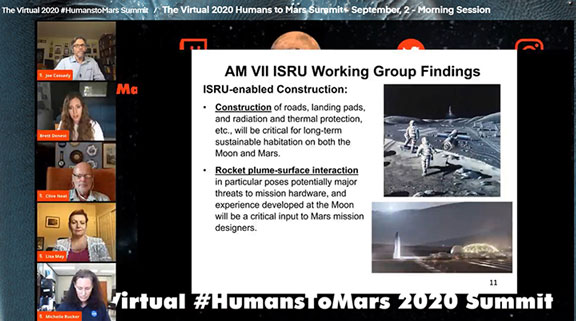 |
ISRU also needs to focus on rocket plume mitigation (Source: 2020 Humans to Mars Summit)
|
|
In summary, ISRU makes possible longer stays on the Moon and Mars in order to "Go, Land, Live and Explore." The goal of ISRU includes mining to get raw materials for construction and fabrication of rocket fuel so that these materials do not have to be bought up from Earth.
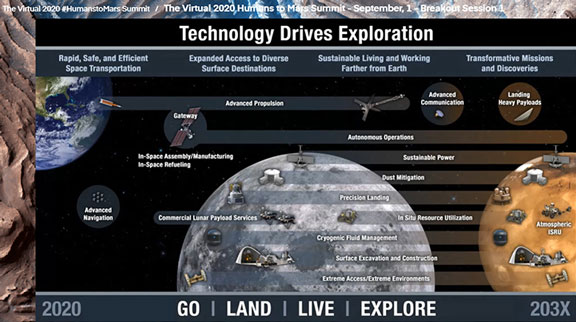 |
Exploration and living on Mars needs a lot of surface energy (Source: 2020 Humans to Mars Summit)
|
|
Ok, so the final dream of Humans to Mars campaign is that permanent settlements such as this artists' conception can be turned into reality.
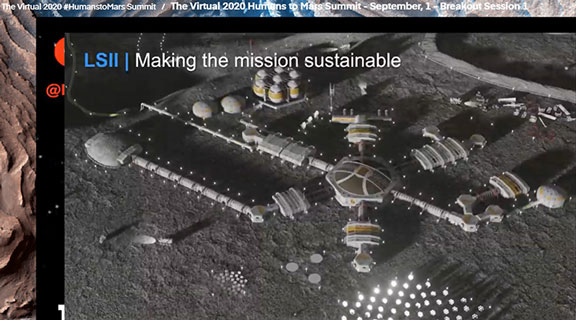 |
How long for distant outputs being independent of Earth? (Source: 2020 Humans to Mars Summit)
|
Making water, oxygen, rocket fuel and building materials is fine, but in addition some of the infrastructure studies looking into food production on Mars include some other "essential" ingredients like booze and wine. I had no idea that Budweiser had already conducted some experiments on the ISS. Hmm, I think we might adapt to life on Mars after all!
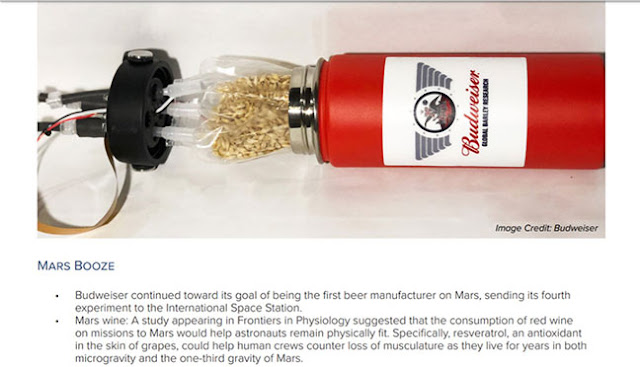 |
Mars wine now; Romulan Ale later? (Source: H2M 2020 Annual Report)
|
Finally, even though we might have wine on Mars, we can't forget the universal principle of physics like superposition. Here we see in addition to Schrodinger's Cat we also now have Schrodinger's Wine.
 |
Superposition of states is a universal principle of physics (Source: Tom Gauld, New Scientist, Aug 29)
|
Until next time, here from our burrow, stay safe, as we recover more of our freedom,
Resident Astronomer George
Be sure to check out over 400 other blog posts on similar topics
If you are interested in things astronomical or in astrophysics and cosmology
















No comments:
Post a Comment